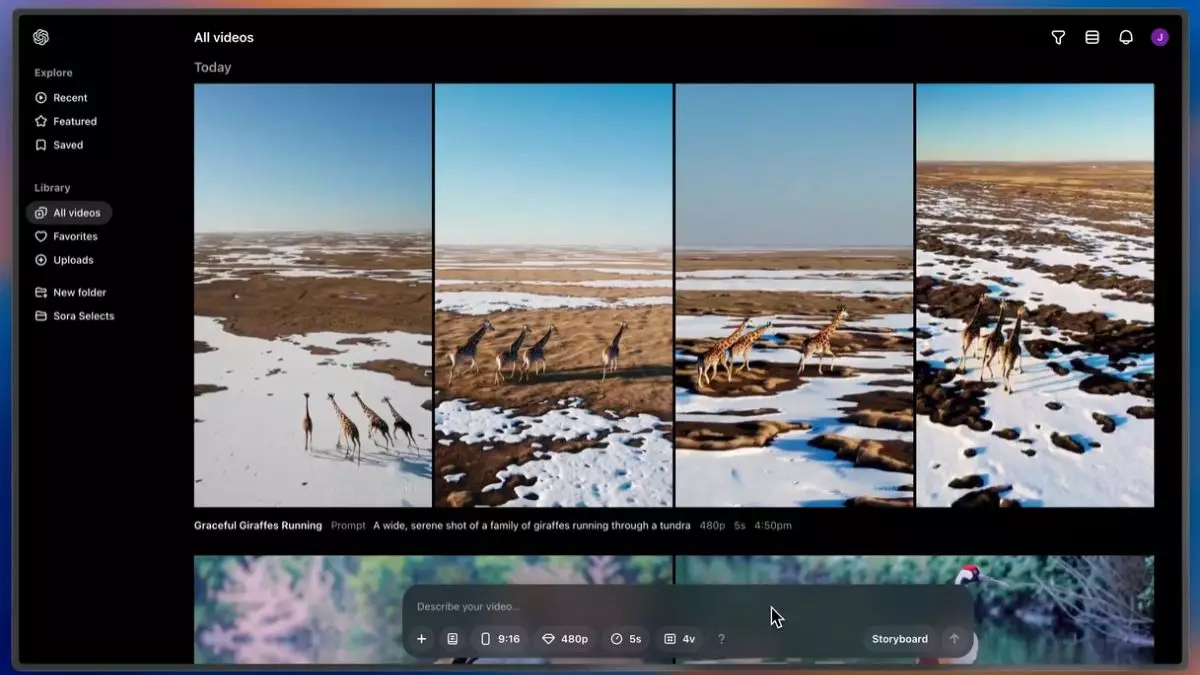OpenAI has reached a significant milestone with the launch of its artificial intelligence video generation model, Sora, which was released on Monday. Initially revealed in February to a select group of individuals, Sora’s potential has been further expanded with the introduction of a variant dubbed Sora Turbo. This newly minted AI model is designed to produce high-quality videos at 1080p resolution, with the ability to create short clips lasting up to 20 seconds. Notably, Sora has been deployed as a standalone platform, which users can access via its dedicated website, a significant move in the arena of AI-powered creative tools.
Currently, access to Sora is restricted to paid subscribers of ChatGPT, limiting its adoption to individuals who possess a ChatGPT Plus or Pro subscription. This exclusivity has stirred conversations about the accessibility of advanced AI tools, as those who are not subscribers cannot create an account on the platform. For Plus subscribers, usage is capped at 50 videos produced at a resolution of 480p or fewer videos at a slightly higher resolution of 720p each month. In an effort to cater to a higher tier of creators, the recently introduced Pro subscription at a steep price of $200 per month offers users an expansive allowance—reportedly “10x more usage,” the specifics of which remain nebulous.
This tiered access system raises questions about the implications of such limitations on creativity and fair use, especially for content creators and small businesses. While the advantages of higher resolutions and longer durations may appeal to professional users, this model inherently excludes a wider audience who might benefit from such innovative technology. The disparity in access highlights the need for a more democratized approach to AI tools, ensuring that aspiring creators are not left in the shadows of technological advancement.
Sora’s creative capabilities are impressive, allowing users to generate videos across various aspect ratios, including widescreen, vertical, and square formats. Its ability to remix or blend user-uploaded materials enhances the creative potential, as individuals can build on existing content rather than starting from scratch. Users can also leverage text prompts to produce entirely new videos, facilitated by a user-friendly storyboard interface that provides structured input for each frame.
Technically, Sora operates as a diffusion model, providing the AI with foresight into multiple frames to maintain continuity throughout the short video duration. This consistency is vital for video production, as it helps to create a cohesive narrative within the constraints of a brief clip. Integrating transformer architecture from DALL-E 3 further strengthens Sora’s capabilities, showcasing OpenAI’s commitment to building sophisticated models that leverage past innovations in AI research.
OpenAI has taken significant steps to collect diverse datasets for Sora’s training, tapping into various public domains and forming partnerships with organizations such as Shutterstock and Pond5. These efforts to generate proprietary data reflect a thoughtful approach to harnessing the wide array of existing visual content while adhering to ethical standards. The incorporation of original datasets also positions Sora favorably in terms of creativity and originality, attributes that are crucial in the world of AI-generated visuals.
Nevertheless, the growing capabilities of AI video generation do not come without ethical dilemmas. OpenAI has acknowledged these risks and implemented measures to mitigate potential abuses that can arise from such powerful technology. This includes an invisible watermark and specific metadata aimed at maintaining content integrity, aligning with regulations set by organizations like the Coalition for Content Provenance and Authenticity (C2PA). These precautions are especially critical given the risks associated with deepfakes and other forms of potentially harmful content.
Moreover, Sora’s framework has been designed to automatically filter out content involving child exploitation or sexual abuse, reflecting a responsible approach to the proliferation of AI-generated materials. By limiting user uploads at launch, OpenAI demonstrates a commitment to policing the environment created by its technologies, fostering a safer ecosystem for all.
Sora’s launch marks a momentous occasion for OpenAI, presenting a platform that combines cutting-edge technology with creative possibilities. As Sora settles into its new role within the AI landscape, it offers insights into how the company envisions the interplay between AI advancements and ethical responsibility. While its subscription-based model may limit initial access, the potential for transformative creative applications remains vast. Moving forward, the continued evolution of Sora and similar technologies will undoubtedly shape the future of content creation and redefine the boundaries of artistic expression in the digital age.

Leave a Reply